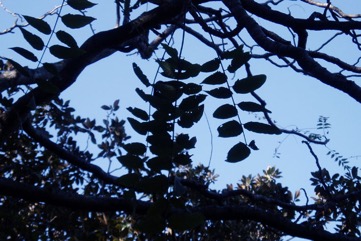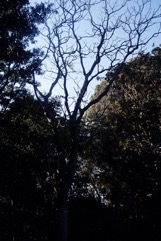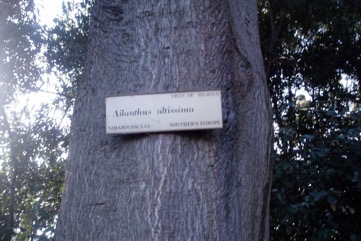Tree of heaven, Chinese sumac

It is a temperate plant. It is native to China. It is drought and frost resistant. It will grow on most soils. It has become a problem plant in some areas of Australia. It cannot tolerate shade. It is naturalised in temperate North and South America. In Argentina it grows between sea level and 800 m above sea level. It needs an annual temperature between 10-20°C and areas with an annual rainfall between 300-2,500 mm. It grows in hardiness zones 5-10. Melbourne Botanical gardens.
Also known as:
Ailanto, Chouchun, Stinking Chun
Synonyms
- Ailanthus glandulosa Desf.
- Toxicodendron altissimum (Mill.)
Edible Portion
- Leaves
Where does Tree of heaven grow?
Found in: Argentina, Asia, Australia, Britain, Canada, Chile, China, Cyprus, Europe, India, Iran, Iraq, Japan, Korea, Mediterranean, Morocco, New Zealand, North America, Pakistan, South America, Taiwan, Tasmania, Turkey, Uruguay, United States
Notes: There are 5-10 Ailanthus species. When plants are put into marshy areas they drain the soil and thereby remove mosquito breeding sites. The plants have extensive root systems and sucker freely, they can be used in soil-stabilization programmes . Since the plant is tolerant of soil pollution it can also be used in land reclamation schemes on old mine tips etc. (From PFAF). It can become invasive.
Status: The leaves are a famine food.
Growing Tree of heaven, Chinese sumac
Cultivation: It is grown from seed or from suckers near the base of the tree. Male and female plants must be grown if seed is required. Seed need 8 weeks cold treatment to enable them to germinate well. Root cuttings can be used.
Edible Uses: The young leaves have been cooked and eaten as an emergency food. They possibly contain some poisons. CAUTION: The flowers can irritate the skin. The plant produces a greenish-brown honey.
Production: A tree that is fast growing but short lived. It can live for 75 years.
Nutrition Info
per 100g edible portion| Edible Part | Energy (kcal) | Protein (g) | Iron (mg) | Vitamin A (ug) | Vitamin c (mg) | Zinc (mg) | % Water |
|---|---|---|---|---|---|---|---|
| Leaves | - | - | - | - | - | - |
Tree of heaven, Chinese sumac Photos



References
Altschul, S.V.R., 1973, Drugs and Foods from Little-known Plants. Notes in Harvard University Herbaria. Harvard Univ. Press. Massachusetts. no. 1960
Ambasta S.P. (Ed.), 2000, The Useful Plants of India. CSIR India. p 23
Biocyclopedia Edible Plant Species. biocyclopedia.org
Blamey, M and Grey-Wilson, C., 2005, Wild flowers of the Mediterranean. A & C Black London. p 124
Bodkin, F., 1991, Encyclopedia Botanica. Cornstalk publishing, p 60
Brown, D., 2002, The Royal Horticultural Society encyclopedia of Herbs and their uses. DK Books. p 107
Coombes, A.J., 2000, Trees. Dorling Kindersley Handbooks. p 296
Cundall, P., (ed.), 2004, Gardening Australia: flora: the gardener's bible. ABC Books. p 119
Etherington, K., & Imwold, D., (Eds), 2001, Botanica's Trees & Shrubs. The illustrated A-Z of over 8500 trees and shrubs. Random House, Australia. p 82
Facciola, S., 1998, Cornucopia 2: a Source Book of Edible Plants. Kampong Publications, p 230
Farrar, J.L., 1995, Trees of the Northern United States and Canada. Iowa State University press/Ames p 232
J. Wash. Acad. Sci. 6:495. 1916
Lamberton, K (Ed.), 2004, The Australian gardening encyclodepia. Murdoch Books, NSW Australia. p 153
Harris, E & J., 1983, Field Guide to the Trees and Shrubs of Britain. Reader's Digest. p 170
Hedrick, U.P., 1919, (Ed.), Sturtevant's edible plants of the world. p 31 (As Ailanthus glandulosa)
Heywood, V.H., Brummitt, R.K., Culham, A., and Seberg, O., 2007, Flowering Plant Families of the World. Royal Botanical Gardens, Kew. p 304
Lamp, C & Collet F., 1989, Field Guide to Weeds in Australia. Inkata Press. p 8
Little, E.L., 1980, National Audubon Society Field Guide to North American Trees. Alfred A. Knopf. p 539
Lord, E.E., & Willis, J.H., 1999, Shrubs and Trees for Australian gardens. Lothian. p 46
Luo, B., et al, 2019, Wild edible plants collected by Hani from terraced rice paddy agroecosystem in Honghe Prefecture, Yunnan, China. Journal of Ethnobiology and Ethnomedicine 15:56
Marinelli, J. (Ed), 2004, Plant. DK. p 443
Paczkowska, G . & Chapman, A.R., 2000, The Western Australian Flora. A Descriptive Catalogue. Western Australian Herbarium. p 534
Plants for a Future database, The Field, Penpol, Lostwithiel, Cornwall, PL22 0NG, UK. http://www.scs.leeds.ac.uk/pfaf/
Schuler, S., (Ed.), 1977, Simon & Schuster's Guide to Trees. Simon & Schuster. No. 79
Valder, P., 1999, The Garden Plants of China. Florilegium. p 263
www.worldagroforestrycentre.org/treedb/
Young, J., (Ed.), 2001, Botanica's Pocket Trees and Shrubs. Random House. p 78